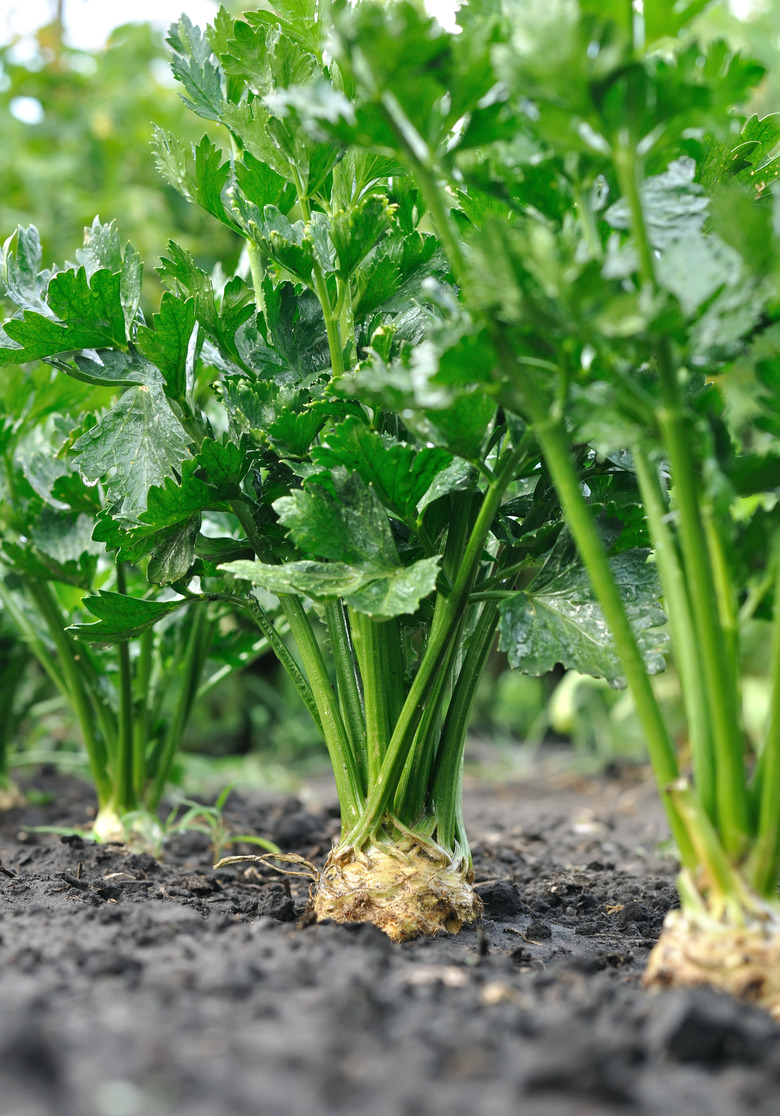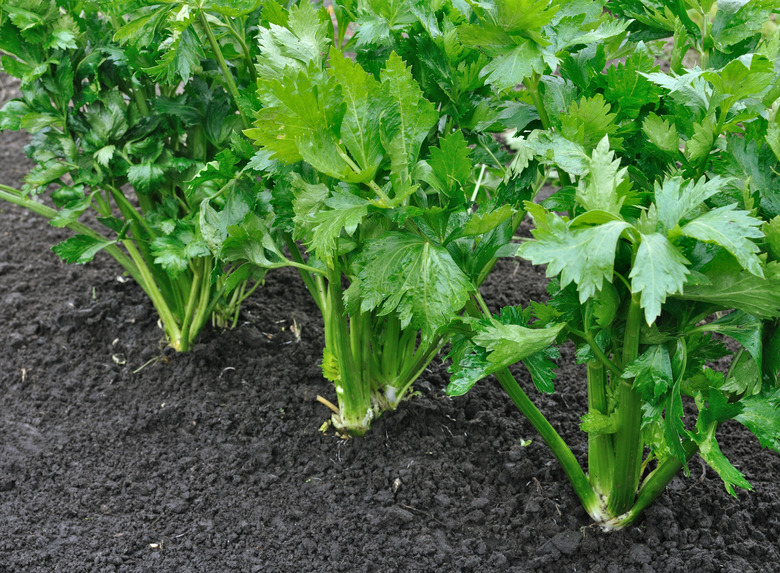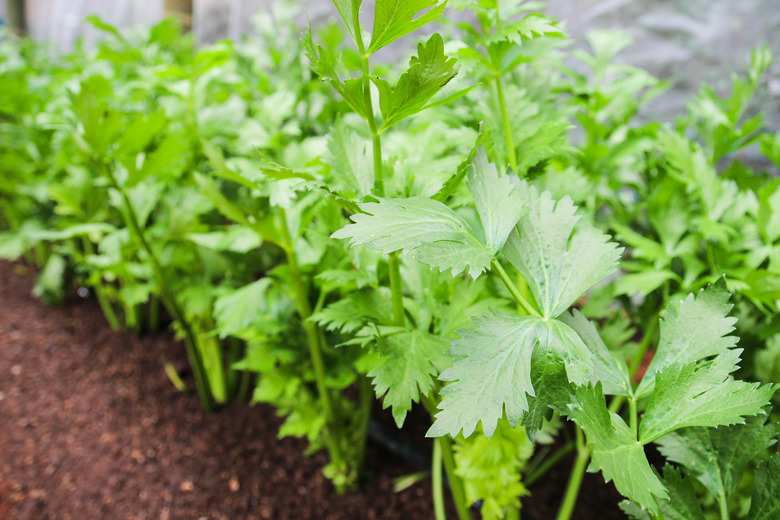How To Grow Celery
Celery (Apium graveolens var. dulce, USDA zones 3-6) is a hardy biennial, but it is usually grown as an annual vegetable. The parts of the plant that are usually eaten are the pale-green, leaf-top stalks that are joined together at the base. While many enjoy the crunchy texture and delicate, salty taste of celery stalks, growing celery in the home garden is a challenge. The vegetables need a long growing season without any weather extremes.
Given the very long growing period required, it is better to start these plants indoors from seed. In addition, celery seedlings are not always available in garden stores. Celery's ideal growing temperature range is 60 to 65 degrees Fahrenheit. It will tolerate a broader range from 45 to 75 degrees, but this makes celery a difficult and sometimes unrewarding crop since it can be hard to find a four-month growing period within that temperature range.
You can plant trenching celery varieties or self-blanching celery varieties. With trenching celery, you need to keep the soil mounded up against the celery stems as they grow. The goal in doing this is to produce crisp, pale stems. This is easier when you actually plant the celery in a trench, which gives it the name. However, you can also blanch celery by using cardboard tubes, pipes or collars. Self-blanching celery naturally turns out crisp, pale stems, so you can get the same taste with a lot less effort. It is considerably easier to grow.
Best Uses for Celery
Best Uses for Celery
Celery is grown exclusively as an edible vegetable. Many consider it a kitchen staple to be used in stir fries, salads and stews. It is a classic addition to holiday stuffing and is also crunched raw or with peanut butter slathered on top.
Garden celery may or may not taste better than celery from the grocery store, but the difference is not as marked as other crops like strawberries, tomatoes and zucchini. Still, commercial celery has many chemicals on it, while celery from the home garden has no chemicals if you abstain from using them. So, some gardeners get swept up in the challenge of succeeding with this crop and plant celery just to prove that they can make it grow.
Celery is a cool-weather crop. That means it is planted in early spring in cooler regions for a summer crop but in late summer for a harvest in early winter in areas with warm summers. This is a plant that cannot tolerate hot weather or cold snaps. It must have four months of relatively mild weather.
How to Grow Celery
How to Grow Celery
- Common Name: Celery
- Botanical Name:
Apium graveolens var. dulce - When to Plant: Plant this cool-weather crop in early spring in cool-summer areas for an early summer harvest. Plant celery in late summer in warm-summer regions for a harvest in late fall or early winter.
- USDA Zones: 3-6
- Sun Exposure: Full sun
- Soil Type: Moisture-retentive soil that drains slowly
- When it's in Trouble: Stalks will be small and dry if the plant doesn't get generous irrigation
- When it's Thriving: Produces edible 12- to 18-inch stalks
Starting Celery From Seed
Celery needs a very long growing season of around four months of cool weather. That means it is best to start the seeds indoors. Take care since the seeds are very tiny.
For a crop in early summer, start the seeds indoors around 10 to 12 weeks before the date of the last spring frost. That means that for a May/June crop, you must start your seeds in November or December. For a late-fall crop, you'll need to stat your seeds 16 weeks before the first fall frost date.
The seeds germinate better if you soak them in warm water for 12 hours before planting. Don't bury these seeds; just press them gently into the good-quality seed-starting soil mix. To the extent possible, space seeds an inch apart.
Once they germinate, use a fluorescent grow light a few inches above the seedlings for 16 hours a day, keeping the temperatures between 60 degrees at night and 75 degrees during the day, misting regularly. The plants will need to go into new and deeper soil when they are 2 inches tall. Use deeper flats or individual pots.
Starting Celery From a Seedling
When you have grown or purchased celery seedlings, they can go outdoors when night temperatures are consistently above 40 degrees and soil temperatures stay at or above 50 degrees. Harden off the young seedlings starting two weeks before transplant by letting them spend increasingly longer periods of time outside each day. Move the seedlings outdoors for a few hours the first day, making sure to avoid temperature extremes. The next day and each subsequent day, extend the time a little. After 10 to 14 days, they are acclimated and ready for transplant.
When it's time to put the seedlings into the ground, space the plants 6 to 12 inches apart. If you are planting several rows, leave 8 to 40 inches between them.
In What Zone Does Celery Grow Best?
In What Zone Does Celery Grow Best?
Celery is a hardy biennial, meaning it can live two seasons, flowering and dying in the second. However, it is almost always grown as an annual crop. You can grow celery as a biennial in its hardiness range across USDA zones 3-6 or as an annual in zones 2 through 10.
Celery is a cool-weather crop and requires a stretch of 16 mild-weather weeks to come to harvest. That means that in places with mild summers, it can be planted in early spring, but in areas with hot summers, it should be planted toward the end of summer for a late-fall or early winter harvest.
Celery will not tolerate extreme weather, and either a cold snap or a hot spell can kill or damage the plant. This makes celery a real challenge in many gardens.
When Should You Plant Celery?
When Should You Plant Celery?
Those gardeners who aim for a late-spring harvest need to start their celery seeds indoors about four months before harvest. Gardeners usually count back 10 weeks from the date of the last spring frost. They transplant the seedlings outdoors after that frost date and leave the seedlings to grow outdoors for six weeks.
Those gardeners who want their celery crop in late fall or early winter count back from the first frost date. They sow their seeds 16 weeks before that date and transplant them outdoors about six weeks before that date.
Soil, Sunlight and Water Recommendations for Celery
Soil, Sunlight and Water Recommendations for Celery
Many garden vegetables prefer or even require soil with tip-top drainage. However, celery doesn't share this preference. This vegetable needs soil that can hold on to water — that is, soil with high organic content, or moisture-retaining soil. You'll want to work a thick layer of organic compost into the soil before transplanting the seedlings.
Celery is a vegetable that requires regular fertilizer even with the organic compost added to the soil. This heavy feeder does best with applications of a high nitrogen and phosphorus fertilizer (16-20-0) every few weeks during the growing season.
Celery plants grow best in bright, direct sunlight. That means they prefer at least six hours of sun every day. On the other hand, they are a cool-weather crop, so be sure that you are planting them at a time of year when they won't scorch. In very warm areas, it is best to plant them where they will be shaded from afternoon sun.
And what about water? Celery never turns down a drink. The plants need the soil to stay moist all the time, so touch it every day and see if it's getting dry. Dry soil means thin, hard celery stalks.
How to Harvest Celery
How to Harvest Celery
Celery is ready to harvest about three to five months after seed sowing. Generally, gardeners harvest only the above-ground celery stalks. However, you can also use the leaves and roots as food or seasoning—and many claim you can even use it as a natural medicine. Herbalists suggest celery for arthritis and nervousness. The vegetable is also recommended as an antiflatulent, antilactogen and aphrodisiac (though, of course, you should always check with a physician before you start a natural remedy for any ailments you have).
You can harvest whole plants at a time or simply harvest stalks from the outside in as you need them. Harvesting stalk by stalk keeps the plants producing longer. Start when the stalks are some 8 inches tall, or if you are harvesting the entire plant, start when it reaches 3 inches or more in diameter. Save the inner stalks for eating raw since they are the most tender.
Don't harvest celery in dry, hot weather. It is said to be tough, stringy and bitter if it is picked when the weather is dry.
Common Pests and Other Problems for Celery
Common Pests and Other Problems for Celery
Celery grows slowly, and its root system is shallow. That means that most weeds can get the best of it. You'll need to take out weeds regularly to keep on top of this problem. Use organic mulches to keep weed growth down and also to keep moisture in.
Slugs will munch on young celery shoots when they are first transplanted. Use a beer trap to lure away the slugs and drown them. Yes, that means you set out beer in a bowl and the slugs slide in to consume it and are then unable to get out.
Earwigs eat holes in your celery leaves. Control them with bamboo traps or pieces of hose. Lay 1-foot sections of one of these items in the celery beds, and the earwigs will congregate there. Dump them into a container of soapy water first thing in the morning.
Flea beetles also poke holes in celery leaves, weakening the plants. These look like shotholes. You can use white sticky traps to capture flea beetles.
Other pests may also attack celery. Protect young plants with row covers (garden fabric) for about a month after planting them outdoors.
Common Diseases for Celery
Common Diseases for Celery
Powdery mildew is a fungal disease that can attack celery. You'll recognize it easily since it looks like a sprinkling of white powder on the leaves. Spray the plants with neem oil as a preventative fungicide.
Blackheart is essentially a calcium deficiency that results in a discoloration and blackening of the tender young leaves at the center of the plant. Adding ample organic compost or manure to the soil before planting prevents this deficiency.
References
- Utah State University Extension: Celery
- UC Master Gardeners, Santa Clara County, CA: Celery
- Master Gardener Association of San Diego County: Celery
- Mother Earth News: All About Growing Celery
- The Old Farmer's Almanac: Growing Celery
- Gardening Know How: What Is Blackheart Disorder: Learn About Calcium Deficiency In Celery
- Drugs.com: Celery Uses, Benefits & Dosage


